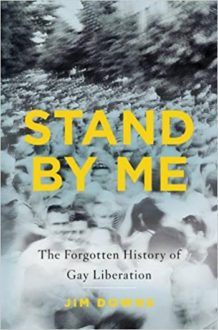 Stand By Me:
Stand By Me:
The Forgotten History of Gay Liberation
by Jim Downs
Published by Basic Books
Published March 1, 2016
History
272 pgs. • Find on Amazon.com
Reviewed by Wayne Dynes
March 1, 2016
With its many vicissitudes, the history of the gay-rights movement stretches back to the 19th century in Germany. In America the seventies are a meaningful unit, being bracketed by the Stonewall Rebellion of 1969 on the one hand and the beginning of the AIDS crisis on the other.
While it was not the start of the gay movement—a common misconception—Stonewall marked the time when the movement went into overdrive. This is when many institutions took root, such as the gay bookstores and newspapers, gay legal efforts, and gay churches and synagogues. It is on these developments that Downs selectively focuses.
In his selectivity, he has chosen to feature a few iconic activists, leaving out such major contributors as Arthur Warner in Princeton; Barbara Gittings in Philadelphia; Frank Kameny in Washington, D.C.; Bill Kelley in Chicago; and Betty Berzon and Morris Kight in Los Angeles. Moreover, the book is exclusively concerned with North America. In fact the seventies was the era in which the American movement, itself based on European roots, spread its influence massively in Europe and eventually through much of the rest of the world. One finds nothing of these momentous changes here.
Even accepting that limitation, one must flag the unfortunate subtitle: “The Forgotten History of Gay Liberation.” This history has not been forgotten at all, as one can see by consulting the relevant chapters of major books on the American gay movement by Dudley Clendinen and Adam Nagourney, John Loughery, and Lillian Faderman.
Had he made more abundant use of these books, Downs would not have been tempted to set up a straw man in his claim that the seventies is regarded as exclusively about sex. To be sure, the gay reflex of the sexual revolution was important, as seen in the backrooms, bath houses, porno theaters, and other forms of public sex that thrived in that era. But they operated in tandem with the more respectable institutions that Downs seems to regard as the only significant thing happening in the seventies. In other words, the man who patronized the baths one night might go to a gay bookstore on the following day. The two sets of clientele were not mutually exclusive.
A common saying is that an author should sweat so that the reader doesn’t have too. Clearly Downs has labored long and hard on this volume, and the result is, for an academic book, refreshingly accessible. You won’t be bored. Yet because of its flawed premises, the work cannot be regarded as an essential contribution.
© 2016 by Wayne Dynes and The Tangent Group. All rights reserved.

